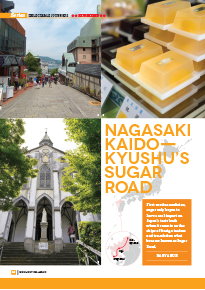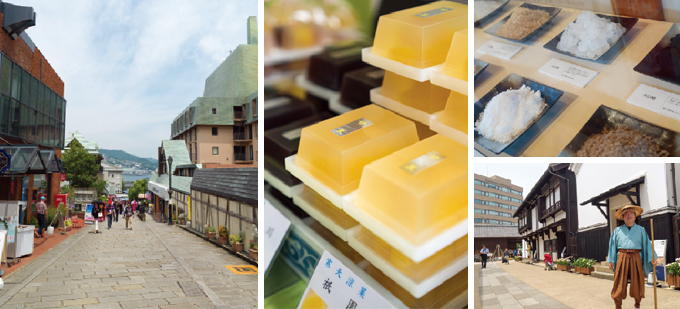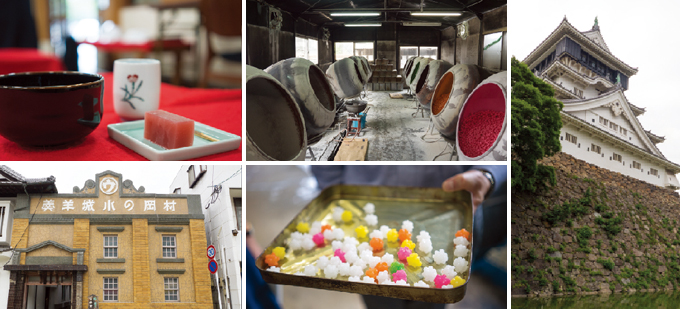Home > Highlighting JAPAN >Highlighting Japan June 2015> Delectable Journeys
Highlighting JAPAN

Delectable Journeys
Nagasaki Kaido—Kyushu’s Sugar Road
First used as medicine, sugar only began to have a real impact on Japan’s taste buds when it came in on the ships of foreign traders and traveled on what became known as Sugar Road.

Everybody loves sugar. After all, the sweet tooth is believed to be an ancient craving that gave us evolutionary advantages because of the energy sugar supplied. So great is humankind’s love for sugar that we find distinctive sugar cultures all across the globe, and Japan is no exception.
The best way to explore Japan’s sugar culture is to follow Nagasaki Kaido, a 228-kilometer road traversing the island of Kyushu. It was so crucial to the creation of classic Japanese sweets and sugar culture that it came to be known as “Sugar Road.”
Japan’s love affair with sugar began in the Nara Period (710–794). Initially used as medicine, sugar became a confectionary ingredient during the Muromachi Period (1336–1573). When the Portuguese first made contact with Japan in 1543, marking the beginning of the Namban trade era, sugar was still a rare commodity. Sugar imports from Europe into Nagasaki gained in scale, however, and more of it was sent on to Edo (Tokyo) via Nagasaki Kaido during the Edo Period (1603–1868). Parts of these shipments landed in the hands of the local populace as payment or gifts, enabling the propagation of a distinctive culture of sugar along the way.
Nagasaki, the trailhead of Sugar Road, was a sleepy fishing town before the arrival of the Portuguese. The European influence still lingers, manifested in a singular Western-based architectural style infused with Japanese flair. Terrific examples include the former British Consulate—made of striking vermilion bricks—and the pristine Oura Church, the oldest church in Japan.
Delving deeper into the city, gold lettering, red lanterns and bold colored signs mark the entrance to Chinatown. Nagasaki has a thriving Chinese community that dates back to before the full implementation of the sakoku edict in 1639, when all foreign nationals except Chinese and Dutch traders were expelled from the country. This vibrant street acts as a virtual time machine: upon exiting the tunnel of red and gold, visitors find themselves in the former Chinese settlement, where beautiful Chinese temples stand shoulder to shoulder. During the heyday of Sugar Road, these temples accumulated great wealth through Chinese traders who gave alms in the form of sugar.
A short tram ride away is Sugar Road’s true origin point—Dejima. Built in 1636, this artificial island served as a confinement zone for Dutch trading companies, and was the sole point of contact between Japan and the West during the country’s isolation. Imported sugar was unloaded, inspected and shipped from here to the rest of the nation. The island, rebuilt to represent its pinnacle as a trading port, is arguably the highlight of any visit to Nagasaki. A stroll through the beautiful wooden structures—which you can enter and explore, and enhanced with comprehensive exhibits and reenactments of daily life—paints a vivid picture of life in Japan during the sakoku period.
With what would now equate to twenty million dollars’ worth of sugar being imported and sent up Sugar Road each year at its peak, significant amounts filtered into the surrounding regions. This happened in various ways, including sugar being purposely spilled and pocketed by dockworkers, being used for payment or given as gifts by the Dutch trading firms, and even being swapped for silver in a manner similar to transactions at the Chinese temples. This was how Kyushu’s sugar craze was fueled.

Visitors venturing down Nakadori, the oldest shopping street in Nagasaki, will come across a matte black traditional Japanese building with a potent aura of history. This is Iwanaga Baijyuken, a Japanese confectionary shop established in 1830. Baijyuken’s iconic castella—the Japanese take on Portuguese sponge cakes—are moist yet ridiculously fluffy. Although there are several noteworthy confections in Nagasaki, castella are the crown jewel. Given their golden butter hue and well-rounded sweetness, it’s easy to understand why. Castella originally had a bread-like texture; it was the sugar coming along Sugar Road finding its way into the people of Nagasaki’s recipe that resulted in the sweet delicacy enjoyed today.
Further north is the city of Ogi in Saga Prefecture, which boasts world-leading consumption of yokan. Yokan originated in China as a form of mutton soup, which in Japan was replaced by red bean paste, agar and sugar. Amid the rolling green hills and ancient shrines are streets lined with yokan factories, including Muraoka Sohonpo, progenitor of Ogi-style yokan. Muraoka Sohonpo is distinctive in its use of traditional methods, which involve cutting the yokan into blocks prior to sale. The result is a crystalline appearance that allows consumers to enjoy a crispy exterior and freshly cut lusciousness on the interior—an irresistible combination. This delectable treat, first introduced in 1899, can credit Sugar Road for its popularity. Be sure to try the sakura yokan variation, which uses white bean paste, resulting in a beautiful, light-pink color.
The next stop is Jinnoharu in Fukuoka Prefecture, home of the only remaining konpeito (a type of Japanese hard candy) producer west of Osaka. The town seems as far removed from sugar as it can get, with sprawling factories and a surplus of industrial machinery. However, nestled in a quiet corner stands Irie Seika, stalwart producers of Japanese hard candy. Founded in Osaka, Irie Seika moved production here in 1934 and found great success, also attributed to Sugar Road waking the sugar hounds within the local population. Their signature product, konpeito, is a simple sugar candy with an unforgettable 3D star shape, said to be a playful twist applied by Japanese craftsmen. The process of achieving this shape requires a daunting two weeks of rolling in giant, heated drums. Irie Seika has recently begun adding flavored variations, including green tea, basil and even ramen. Each of these variants is extremely well executed, giving the candies new spark without adulterating them.
Nagasaki Kaido terminates in an ancient castle town called Kokura. Wandering through the town’s streets, it is marvelous to see how integrated ancient and modern elements are here. Shopping complexes merge seamlessly with the grounds of regal Kokura Castle, while cobbled roads intersect with paved streets. Upon arriving in Kokura, sugar was loaded onto ships and sailed through the Straits of Shimonoseki toward Edo.
While just a little over two hundred kilometers long, the influence Sugar Road had on Japan was profound. It introduced sugar to the palates of the Japanese people and primed the people of Kyushu and later the rest of Japan to crave that sweetness. This in turn resulted in a taste revolution, through both the creation and success of various confections, and the regular use of sugar in cooking. Nagasaki Kaido left an enduring trail of treats and sugar culture along its course.
© 2009 Cabinet Office, Government of Japan






